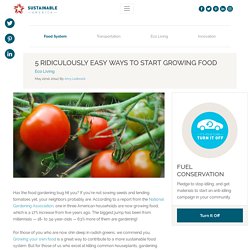Solutions to All Problems
> Challenges Farmers Face
(1) What If We Built Vertical Farms?
(1) The Future of Farming. Cool Jobs: Finding foods for the future. Meet dulse, a seaweed with a secret.

This translucent red alga grows along northern, rocky coastlines of the Atlantic and Pacific oceans. And its colorful, leathery fronds hide a remarkable flavor. When tossed with oil and fried in a pan, they taste like bacon. “I think it is a food of the future,” says Chris Langdon. This marine scientist has been studying dulse for more than a decade at Oregon State University in Portland.
DLT, anyone? People need to seek out new foods because the world has so many mouths to feed. And that quest is becoming ever more urgent. Sign Up For the Latest from Science News for Students. The Future of Farming & Agriculture. 5 Innovative Agricultural Practices That Are Changing the World. By Andy Heikkila Digitization in the modern age means that almost every contemporary field or industry is becoming more and more reliant on hardware connected to and, in some cases, controlled by software.

These industries are being transformed from the inside out by innovative technology and practices, and even traditionally analogue ways of life are finding it difficult to resist disruption. Agriculture is a prime example of one of these industries, with the experts at Maryville University actually including it as one of ten “on fire” fields for up-and-coming software developers. “The agriculture industry has experienced a massive technological shift of late,” they write. “Precision agriculture involves big data, drones, sensors, and farm management software … Environmental controls, cellular agriculture (micro farms), smart packaging technology, gene manipulation, and e-grocer businesses have also pushed the entire agricultural business world into the computer age.” 1. 2. 3. 4. 5.
5 Ridiculously Easy Ways to Start Growing Food. Has the food gardening bug hit you?

(23) Sustainable Living: Innovative Ways To Grow Your Own Food!
How satellites are being used to for Soil Moisture?
Study Tracks ‘Memory’ of Soil Moisture – SMAP. How To End The Food Waste TED Talk. Five smart ways to fight food waste. iStock An estimated 30 percent of the planet’s food supply is needlessly discarded.

Here are some imaginative ideas to stop the rot.
Reducing Wasted Food At Home. Ways to Reduce Wasted Food Planning, prepping, and storing food can help your household waste less food.

Below are some tips to help you do just that: Planning Tips By simply making a list with weekly meals in mind, you can save money and time and eat healthier food. If you buy no more than what you expect to use, you will be more likely to keep it fresh and use it all. Keep a running list of meals and their ingredients that your household already enjoys. Storage Tips It is easy to overbuy or forget about fresh fruits and vegetables. Find out how to store fruits and vegetables so they stay fresh longer inside or outside your refrigerator.
Food Waste: 17 Actions to Take A Bite Out of This HUGE Global Problem. 5 Ways to Fight Food Waste. 1.

Plan your meals. The more precise you are about what you’re going to eat and when, the less food you’ll waste. Meal-planning apps can help!
The Committee on World Food Security. 4 Innovative ways to locally grow food. 15 ways to celebrate agriculture on Earth Day. Agriculture: it doesn’t have to steamroll the environment to be productive.

For over 40 years, Earth Day has served as a call to action, mobilizing individuals and organizations around the world to address environmental challenges. Agriculture, often blamed as a driver of these problems, is emerging a solution to environmental problems. It’s a source of food and income for the world’s poor and a primary engine for economic growth.
6 Innovative Farmers That Will Change Your Perception of What It Means to Grow Food. The advantage of biodegradable shopping bags is supposed to be that they will not linger as long in the natural environment as conventional plastic bags.

However, a new study from the University of Plymouth suggests that might not be the case. The study, published in Environmental Science and Technology Sunday, found that bags billed as biodegradable could still carry around five pounds of groceries after being buried in soil or submerged in sea water for three years, The Weather Channel reported. "After three years, I was really amazed that any of the bags could still hold a load of shopping.
For biodegradable bags to be able to do that was the most surprising," study leader Imogen Napper said. Researchers compared five types of bags widely available in the UK, according to The Guardian: two oxo-biodegradable bags, a biodegradable bag, a compostable bag and a high-density polyethylene, i.e. conventional plastic bag.
What Can You Do to Help Solve the Global Food Crisis?
Sara Menker: A global food crisis may be less than a decade away. 5 Innovative Agricultural Practices That Are Changing the World. 7 Steps to Solving the Food Crisis. The World Food Program describes the current global food crisis as a silent tsunami, with billions of people going hungry.

Hunger is, indeed, coming in waves, but not everyone will drown in famine. The recurrent food crises are making a handful of corporations very rich—even as they put the rest of the planet at risk. Built over half a century, largely with public grain subsidies and foreign aid, the global food-industrial complex is made up of large corporations that sell grain, seed, chemicals, and fertilizer, along with global supermarket chains and food processors. When these players first came on the scene, world agriculture was different. Forty years ago, the global South had yearly agricultural trade surpluses of $1 billion. International trade agreements and pressure from the global North opened up entire continents to cheap, subsidized grain from the North. For decades, family farmers the world over have resisted this corporate control.









